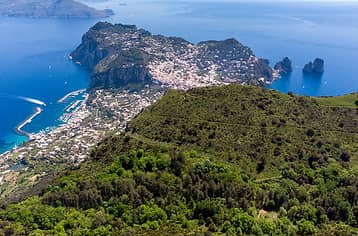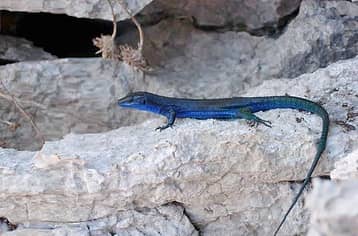- Home
- Experiences
- Fauna and Flora
Fauna and Flora


Naturalists, biologists and zoologists from all over the world have spent time studying the fauna of Capri. The island is home to a variety of small mammals, numerous bird species, including migratory ones, a number of amphibians and a considerable quantity of invertebrates including molluscs, arthropods and insects. Naturally, the marine fauna is of great importance, with the waters around the Island of Capri full of rich and diverse fauna and where it is possible to observe a host of mammals, fish, reptiles and invertebrates.
The flora of the Island of Capri is comprised predominantly of Mediterranean shrubs. The shrubs and trees on the island tend to have small leaves with a thick waxy layer, which reduces to a minimum the loss of water during the hottest hours of the day and protects the plant from drought and from the sun's rays. In the Island of Capri one can find examples of mastic tree, myrtle, arbutus, heather, cypresses and the occasional oak tree. A number of the plants which grow spontaneously on the island are also cultivated in the Flora Caprense Garden in the vicinity of the Piazzetta, others in the gardens of Villa San Michele in Anacapri.
The Blue Lizard (Podarcis sicula coerulea)
The Blue Lizard (Podarcis sicula coerulea)
The Lucertola Azzurra or Blue Lizard is one of a list of reptiles which populate the Island of Capri. Noteworthy characteristics are its blue scales "like the sea and the sky of Capri" and its habitat, which is restricted to the Faraglioni stacks and the Monacone stump. A fine example of animal camouflage, its color makes the lizard both less visible and less appetizing to predators. Zoological studies have demonstrated that the Blue Lizard is identical in all but its color to the Green Lizard which lives on the rest of the Island of Capri.
The Peregrine Falcon (Falcus peregrinus)
The Peregrine Falcon (Falcus peregrinus)
The Peregrine falcon is a bird of prey with a compact, smooth form and short tail. There are only a few pairs of these birds of prey left on the island of Capri. The hunters of Capri distinguish them by their territories, and thus we find the falcon of Tiberio, of Cala Marmolata, Tuoro and Capodimonte.
Cuttlefish (Totarodes sagittatus)
Cuttlefish (Totarodes sagittatus)
Of all the marine invertebrates it is obligatory to mention the cuttlefish. The locals spend many a summer night fishing for this highly rated sea inhabitant the flesh of which forms the basis of a number of typical island dishes. Cuttlefish are chephalopoda belonging to the omnastrephidae family, similar to calamari but with a different form of fin. In addition to the common cuttlefish there are the flying cuttlefish which escape their predators by leaping out of the water. At Capri the Cuttlefish are divided in to Black Cuttlefish and Veracious Cuttlefish, according to the species to which they belong.
Broom (Spartium junceum)
Broom (Spartium junceum)
The Broom flowers on Capri each year from May until June. On the island there are various species belonging to the Broom family, such as the thorny Chamaecytiscus spinescens and the Cytisus scoparius or Common Broom with intense yellow flowers. There is a very special relationship between the broom plant and the two districts of the island, Capri and Anacapri: in Capri it is called the "flower of St. Costanzo", Costanzo being the patron saint of the island, honored on May 14th, when the broom is in its period of maximum flowering; in Anacapri it is called the "flower of St. Antonio", after patron saint of Anacapri, because here it flowers later on in the year, towards mid June, when the celebrations in the Saint's honor are held.
The herbs
The herbs
Herbs are, arguably, the most important gastronomic characteristic of a country's cuisine. On Capri one can be quite overcome by the pungent scents of the Mediterranean. Not surprisingly, it is the habit of every housewife to cram her windowsills with terracotta pots filled with herbs. The typical herbs of Capri are basil, with medium sized green leaves, marjoram, oregano, with small dark green leaves, parsley, and thyme. They all have an extremely intense perfume.
The lemons
The lemons
It is believed that citrus fruits arrived in Capri in the tenth century, and they have characterized the colors and perfume of the island ever since.The lemon, originally used as an ornamental plant, was subsequently used for its superb juice and the essential oils extracted from its peel. Famous throughout the world, the lemon liqueur "Limoncello", is best served chilled.The lemon of Capri, known as "femminiello", has a long elliptical form and medium dimensions. The first fructification occurs in October, producing the juiciest fruits of the year. In March the light yellow lemons, called "bianchetti" ripen, and in June the green "Verdelli" are ready to be picked.This type of lemon has been awarded Protected Geographical Indication (P.G.I) status and can be cultivated, using rigorously organic farming methods, exclusively on the island of Capri and along the Sorrentine Peninsula.
Grapes and wine
Grapes and wine
Wine making on the island of Capri has truly ancient origins, dating back to the Greeks. The Romans used to drink wine diluted with water, and in the seventeen hundreds the wine of Capri was compared to the finest wines of the Campana region, such as the Lacryma Christi produced in the area of Mount Vesuvius. In the nineteen hundreds the island's wine was highly praised by Pablo Neruda and Axel Munthe. Authentic grapes of Capri are the "Uva Rassa" and the "Ventroso". The Rassa grape is typical of Anacapri, and grows under the olive trees, in areas subject to drought and wind: the brunches of grapes are small and the skin of the fruit is thick and bitter. It is used to give body to the wine. The Ventroso grape takes its name from the area of Capri where it is most densely cultivated; it has medium sized bunches of grapes, the grapes themselves are white with a black speck in the center. The grapes are eaten as fruit.
Olives
Olives
The Olives of Capri derive from plants similar to those which can be found on the Sorrentine Peninsula, with small fruits especially well suited to those areas subject to drought. From these olives an excellent oil is made, which was at one time exported, representing a major source of income for the population.